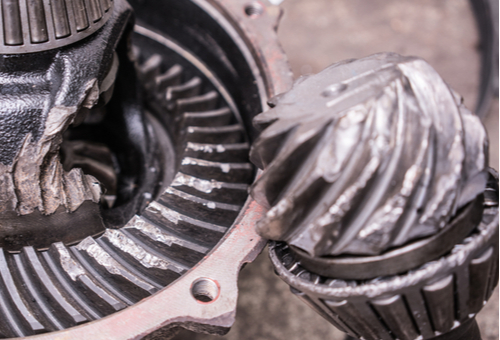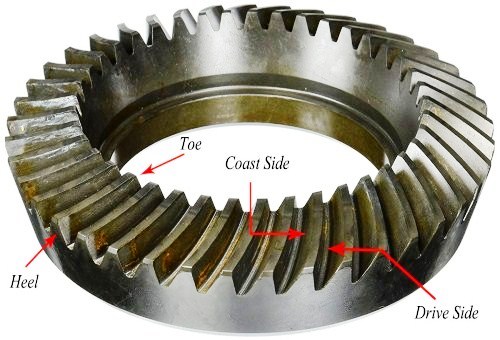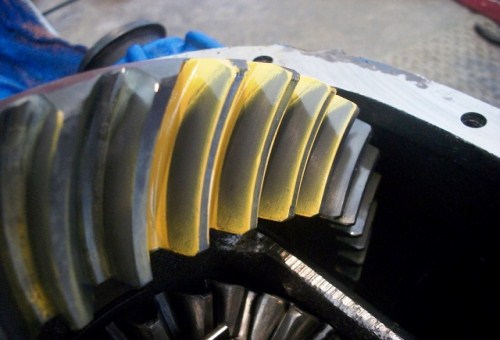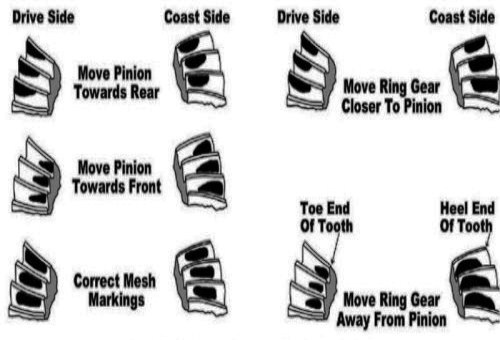
What is your first reaction when you are presented with an RWD, 4WD, or AWD vehicle that is exhibiting clear symptoms of a worn or damaged differential? Do you confirm the issue by checking the lubricant in the diff for metal wear particles and then arrange to have the vehicle referred to a specialist repairer? Fixing or rebuilding differentials is admittedly not everybody's cup of tea, but on the other hand, differentials are not nearly as complicated or difficult to diagnose or set up correctly as you might have been led to believe. If you are not convinced of this, this article will describe what to look out for when diagnosing common problems with differentials, starting with this question-
* Note that because of the fundamental differences between differentials in rear axles and differentials that are incorporated into FWD transmissions, this article will focus solely on differentials used in rear axles on RWD vehicles. Note though that many of the problems and their solutions that apply to RWD axles also apply to differentials used in the front axles of 4WD vehicles.
Contrary to popular belief, differentials do not fail often. Provided that proper lubrication is available at all times and that the differential is set up properly and correctly, most differentials outlast the vehicles they are fitted to.
However, it has been this writer’s experience that in the absence of previous repair work having been performed on a failed differential, most, if not all common differential issues are directly related to shoddy assembly procedures during initial assembly in the factory. Consider this: reputable sources claim that American manufacturers produce about 12 million differentials intended for use on 4WD and AWD vehicles every year. This equates to 32 876 units per day, 1 370 units per hour, or more to the point, 22.83 units per minute. Note that these figures exclude differentials produced for use on passenger or high-powered muscle cars.
The above statistics might seem irrelevant, but the point of it is this; it is simply impossible to set up every one of many millions of differentials correctly all of the time- even with the highly refined mass-production methods and stringent quality assurance/control checks that manufacturers pride themselves on. Thus, there is a very good chance that a significant percentage of vehicles are sold and exported to international markets with differentials that are built to fail: the infamous "Chevy Shake*" being a good case in point.
* The term “Chevy Shake” refers to severe vibrations on many Chevrolet trucks and SUV’s that can only be cured by replacing the differential with a properly set up replacement.
While some readers may find the above somewhat interesting, the fact is that all of it relates to both how and why differentials fail on relatively new and/or low mileage vehicles, which begs this question-
While sudden, catastrophic gear failures are exceedingly rare on standard applications that are not abused, most differential failures involve whining, grinding, or rumbling noises either upon acceleration when the differential is loaded, similar noises when the vehicle is coasting, or in severe cases, a rumbling or grumbling noise when the vehicle is steered around bends and corners.
We have all heard worn or damaged differentials emit these noises, but it is not always clear what causes vibrations that seem to emanate from the rear axle. In some cases, the vibrations correlate with mechanical noises upon either or both acceleration and deceleration, but experienced technicians will agree that in many cases, the standard remedies do not cure the persistent vibrations. For the benefit of those that are new to the car repair trade, “standard remedies” include balancing or replacing the rear wheels/tyres, rebuilding, rebalancing, or replacing the driveshaft, and replacing shackle bushes and other suspension bushings/components that sometimes include shock absorbers and leaf springs. Nonetheless, the principal causes of differential failures are much the same across all applications and could include one or more of the following, but in no particular order-
The above points cover a lot of ground, and while it is not always easy to distinguish between cause and effect when it comes to diagnosing differential issues, you can remove a lot of guesswork from the equation if you know and understand some of the basic terms that pertain to differential repair. Below are some-

Image source: https://www.chevyhardcore.com/tech-stories/drivetrain/rearend-gear-swap/
The image above shows a typical differential ring gear with some important labels added. While “Heel” and “Toe” are largely self-explanatory, the other two terms (with more following) may not be clear if you have not had much exposure to differential repair/rebuilding. Let us start with-
Drive side
This refers to the face (or side) of the gear teeth that are in contact with the teeth on the pinion gear when the differential is loaded upon acceleration, or during cruising conditions when constant power input is required to maintain the vehicles’ momentum. Under these conditions, the pinion gear is the drive gear, and the ring gear is the driven gear.
Coast side
This refers to the side (or face) of the ring gear teeth that are in contact with the pinion gear when engine power is removed from the differential, such as when the vehicle is coasting. Under these conditions, the ring gear becomes the drive gear, and the pinion gear becomes the driven gear because, under coasting conditions, the differential is loaded by the rotation of the wheels, instead of by the engine via the driveshaft.
Hypoid gears
In a hypoid gear train such as the pinion and ring gear set in a differential, the gears are set up in such a manner that their centrelines do not intersect each other at right angles. This arrangement makes it possible to have two teeth on the pinion and two teeth on the ring gear in contact with each other, unlike straight-cut gears where only one tooth on each gear can be in contact with each other.
Backlash
This refers to the amount of rotation that can occur on one gear in a set without the other gear in the set being rotated. This distance is application-specific* and is critically important on all differentials because insufficient backlash causes the gears to bind, while excessive backlash causes excessive mechanical wear. Note that both inadequate and excessive backlash can cause varying mechanical noises.
*Note that this distance is best measured with a dial gauge set up at right angles to a ring gear tooth.
NOTE: Differential backlash is somewhat analogous to valve clearances. While there is a significant clearance between a cam lobe and a cam follower or tappet, the various resistances and reciprocating masses in a valve train prevent the cam followers and the cam lobes from slamming into each other to create the typical tapping noise we all love to hate.
While differentials do not involve reciprocating masses, the built-in resistances in a properly set up differential maintain a situation in which one tooth on the pinion gear comes into contact with a tooth on the ring gear at the exact moment that a tooth on the pinion gear loses contact with a tooth on the ring gear. This eliminates mechanical noise while at the same time, keeping the gear teeth in contact with each other over the biggest possible contact area if the differential is set up correctly.
If however, the backlash is excessive, there is a brief moment during which two gear teeth lose contact with each other before contact between the next two gear teeth is established. The result is that gear teeth slam into each other on either the drive or coast sides of the ring gear teeth (depending on operating conditions) which is what creates the whining noises in differentials that we all love to hate.
Bearing pre-load
This refers to the loads that must be applied to bearings to prevent rotating components that are supported by those bearings from moving in any axis other than their rotational axes. Thus, if all the bearing pre-loads in a differential are correct, all the rotating components in that differential will a), only rotate around their axes of rotation and b), will be unable to orbit their axes of rotation or move in longitudinal, radial, or transverse axes relative to their planes of rotation.
Total Turning Preload (TTP)
This value is also application-specific and refers to the amount of force (torque) that is required to rotate the pinion gear via the pinion nut with a deflecting beam or digital torque wrench. This measurement has huge diagnostic value but to be reliable, TTP values must be obtained with the driveshaft, wheels, and brakes removed from the differential. While TTP values of about 1.7 Nm to about 2.8 Nm are typical for most SUV’s and 4WD vehicles, the obtained value on any differential must be compared to reliable service information for that specific application if misdiagnoses are to be avoided.
As a practical matter, the TTP of a differential is established by a combination of bearing pre-loads and backlash, with backlash being a function of how well (or otherwise) the gear train is set up. Therefore, n TTP value that exceeds a specified value is indicative of excessive bearing pre-loads and/or insufficient backlash, while a TTP value that is lower than specified is indicative of insufficient bearing pre-loads and/or excessive backlash.
All of the above terms and their definitions bear directly on how to diagnose differential issues, as well as how to set up a differential during repair/assembly procedures. However, one very important term, “gear contact pattern” has not been discussed, so let us look at how to you can use this term in-

Image source: https://www.speednik.com/wp-content/blogs.dir/1/files/2017/07/www.speednik.com-rearend-gear-swap-3-drive-backlash-.010.jpg
The image above shows an almost perfect contact pattern*. In this example, the areas on the gear teeth where the yellow marking paint has worn off extend over both the full length and total depth of the ring gear teeth, which is the desired condition**.
* Contact patterns are obtained by removing all traces of lubricant from the ring and pinion gears with a suitable solvent before paining both sides of all the ring gear teeth with special marking paint, or failing that, a high-quality spray paint. Once the paint has dried, the differential is lightly loaded to ensure good contact between the gear teeth, but note that the best results are obtained when the differential is rotated through at least one full revolution of the ring gear via the pinion nut. Note that if the contact pattern on the drive side of the ring gear teeth is acceptable, it is almost certain that the contact pattern on the coast side of the ring gear teeth will also be acceptable. There is no guarantee of this though, so both contact patterns must be obtained before condemning a differential or placing it into service.
** Note that since a given ring gear could have been manufactured in one of two ways, it is sometimes not possible to achieve the type of contact pattern shown above. One manufacturing method involves cutting each gear tooth separately, while the other method involves cutting several gear teeth simultaneously. In the first method, it sometimes happens that some gear teeth are cut deeper than others, while in the second method all the gear teeth are cut to the same depth. Therefore, appropriate allowances must be made when setting up a differential that has a ring gear with unequal tooth depths to avoid either excessive or insufficient backlash between the ring and pinion gears.
In terms of diagnostics, however, the contact pattern is the most valuable aid you will have because this pattern is a direct function of how the differential is set up, so let us consider the image below-

Image source: https://www.chevyhardcore.com/tech-stories/drivetrain/rearend-gear-swap/
The above image shows some examples of contact patterns that you are most likely to see on noisy differentials, but to understand how these types of contact patterns come about you need to understand how the pinion and rings gears are positioned relative to each other. Let us look at how this is done-
Pinion gear
The pinion gear is supported by two bearings, whose pre-loads are established by a crushable spacer between them. When a differential is set up this spacer is crushed by tightening the pinion nut; if the spacer is crushed too much, you get excessive backlash. Conversely, if the spacer is not crushed enough, you get insufficient backlash, so by crushing this spacer, you can adjust the position of the pinion gear relative to the ring gear. Note though that both the pinion nut and the spacer are strictly single-use; if the adjustment is not right on the first attempt, both the spacer and the nut must be replaced for each subsequent attempt.
Ring gear
The ring gear is usually a separate component that bolts onto the ring gear carrier, which is supported by two bearings- one on either side of the ring gear. The pre-loads of these bearings are established by shims and/or spacers on either side of the ring gear, so by removing shims on one side to adjust the position of the ring gear, shims of equal thickness must be added to the other side to maintain the correct bearing pre-loads. Note that on some differentials, the position of the ring gear is controlled by large lockable nuts instead of by shims and/or spacers, which brings us to the topic of-
While limited space precludes a comprehensive discussion of contact patterns and their effects, it is worth mentioning that-
As a practical matter, there are two guiding principles during both fault diagnosis and repair/rebuilding procedures on differentials. The first is the contact pattern, and the second is a backlash- or the lack of a backlash.
Both of these principles bear directly on each other, and while it is relatively easy to diagnose differential faults based purely on these principles, establishing/obtaining the correct amount of backlash, a good contact pattern, and the specified total turning preload at the same time is another matter altogether, and even more so when you have never built a differential before.
Of course, this is not the same as saying that you couldn’t do it if you tried, but your employer will almost certainly not allow you to learn how to repair or rebuild a differential on a paying customer’s vehicle. Nonetheless, the fact is that while anybody can learn to repair or rebuild differentials, actually performing these procedures to industry standards requires dedicated training and practice (and lots of practice, at that) which leaves us with this-
If you have not had the required training, this writer would advise against trying to repair a differential as an experiment just to see if you could do it. However, you could do the next best thing, which is learning how to diagnose differential-related issues and problems accurately because doing so would give you two major advantages over your colleagues.
The first is that you would be able to identify vibrations and other driveline issues nobody else in the workshop could, and the second is that you would be able to provide customers who are having issues with the differentials on their vehicles with clear and unambiguous diagnoses of the causes of their problems, which is perhaps the most important thing to be able to do.